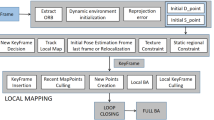Abstract
One of the issues associated with programming a VEX Robotics Competition (VRC) robot for the autonomous period is providing it with enough information regarding its environment so that it can move about the field intelligently. As such, an objective of our research was to develop a series of machine vision tools so that a VRC robot could identify VRC field elements, other robots, and field perimeters; responding appropriately. We have carried out a review of relevant literature and identified a number of algorithms, image processing tools, and control paradigms, as well as, developed our own approaches, which we have implemented in C++ using the OpenCV library. Here we present the results of our initial efforts, namely our implemented colour identification, connected-object separation, and multiple connected-objects separation methodologies.
Access this chapter
Tax calculation will be finalised at checkout
Purchases are for personal use only
Preview
Unable to display preview. Download preview PDF.
Similar content being viewed by others
References
VEX Robotics. A STEM education revolution (2014), http://www.vexrobotics.com/vexiq (last accessed October 2, 2014)
Kiwibots. New Zealand VEX Robotics (2014), http://www.kiwibots.co.nz/ (last accessed October 2, 2014)
Thrun, S., Fox, D., Burgard, W., Dellaert, F.: Robust monte carlo localization for mobile robots. Journal of Artificial Intelligence (2001)
Leymarie, F., Levine, M.D.: Tracking deformable objects in the plane using an active contour model. IEEE Transactions on Pattern Analysis and Machine Intelligence 15, 617–634 (2002)
Vincent, L., Soille, P.: Watersheds in digital spaces: an efficient algorithm based on immersion simulations. IEEE Transactions on Pattern Analysis and Machine Intelligence 13(6), 583–598 (1991)
Trier, O.D., Jain, A.K.: Goal-directed evaluation of binarization methods. IEEE Trans. Pattern Anal. Mach. Intell. PAMI-17, 1191–1201 (1995)
Sezgin, M., Sankur, B.: Survey over image thresholding techniques and quantitative performance evaluation. Journal of Electronic Imaging 13, 146–165 (2004)
Comaniciu, D., Meer, P.: Mean shift: A robust approach toward feature space analysis. IEEE Transactions on Pattern Analysis and Machine Intelligence 24(5), 603–619 (2002)
Sumengen, B., Manjunath, B.S., Kenney, C.: Image segmentation using multi-region stability and edge strength. In: The IEEE International Conference on Image Processing (ICIP) (September 2003)
Fred, A.L.N., Jain, A.K.: Robust data clustering. In: The International Conference of Computer Vision and Pattern Recognition, pp. 128–136 (2003)
Lowe, D.: Distinctive image features from scale-invariant keypoints. International Journal of Computer Vision (IJCV) 60(2), 91–110 (2004)
Belongie, S., Malik, J., Puzicha, J.: Shape matching and object recognition using shape contexts. Pattern Analysis and Machine Intelligence (April 2002)
Torralba, A., Murphy, K.P., Freeman, W.T.: Sharing visual features for multiclass and multiview object detection. In: The IEEE Conf. on Computer Vision and Pattern Recognition (CVPR), Washington D.C. (2004)
Finlayson, G., Hordley, S., Hubel, P.: Color by correlation: A simple,unifying framework for color constancy. IEEE Transactions on Pattern Analysis and Machine Intelligence 23(11) (November 2001)
Forsyth, D.: A novel algorithm for color constancy. International Journal of Computer Vision 5(1), 5–36 (1990)
Rosenberg, C., Hebert, M., Thrun, S.: Color constancy using kldivergence. In: IEEE International Conference on Computer Vision (2001)
Sridharan, M., Stone, P.: Structure-Based Color Learning on a Mobile Robot under Changing Illumination. Autonomous Robots Journal (2007)
Browning, B., Govindaraju, D.: Fast, Robust Techniques for Colored Object Detection in Variable Lighting Conditions
Author information
Authors and Affiliations
Corresponding author
Editor information
Editors and Affiliations
Rights and permissions
Copyright information
© 2015 Springer International Publishing Switzerland
About this paper
Cite this paper
Jing, C., Potgieter, J., Noble, F.K. (2015). A Colour Detection and Connected-Objects Separation Methodology for VEX Robotics. In: Kim, JH., Yang, W., Jo, J., Sincak, P., Myung, H. (eds) Robot Intelligence Technology and Applications 3. Advances in Intelligent Systems and Computing, vol 345. Springer, Cham. https://doi.org/10.1007/978-3-319-16841-8_36
Download citation
DOI: https://doi.org/10.1007/978-3-319-16841-8_36
Publisher Name: Springer, Cham
Print ISBN: 978-3-319-16840-1
Online ISBN: 978-3-319-16841-8
eBook Packages: EngineeringEngineering (R0)




